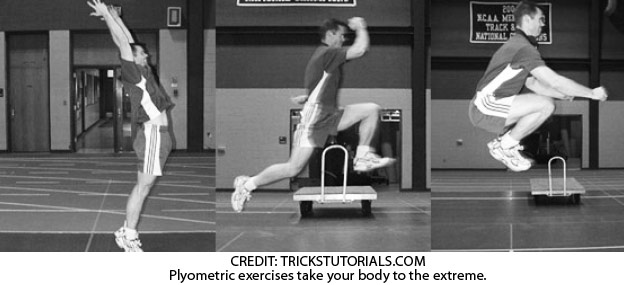Fun and Fitness: Pondering plyometrics

Name one Olympic sport that doesn't require speed, agility or strength. If you choose curling, you are right, but for the most part, this is never the case. For the majority of athletes, speed, agility and strength make up the foundation of training.
But to train in all three areas you have to run, stretch consistently and lift weights frequently, unless of course you do plyometric exercises. But before I begin describing plyometrics, it is important that I stress that plyometrics do not take the place of running, stretching and weight training; they help enhance the results.
Plyometrics are often referred to as explosive movements or explosive exercises. In essence, you are training explosive patterns in order to toughen tissues and train your nervous system into being able to contract specific muscle groups explosively! I think you are getting the hint regarding the importance of EXPLOSIVENESS now!
All plyometric exercises must be done quickly and correctly. There are never any shortcuts. Every action is done with the intent to have a muscle reach full movement as quickly as possible. I am going to cut straight through all of the scientific terminology and eccentric concentric mumbo jumbo and say that if you do plyometrics consistently and correctly, you will see results.
Now that you know what plyometrics aim to improve, you have to write your plyometric workout. The first thing you have to consider is your main goal: Do you want to cut down on your 100 metre dash time, throw the discus farther or jump higher for basketball? Only then will it be easier to tell what type of sport you are going to focus on. As an example, track and field sprints will improve your 100 metre, track and field throwing will improve your discus and obviously basketball plyometric exercises will help you jump higher. It sounds like common sense, but you would be amazed at how many people don't train specifically for their desired goals.
Now that you have your sport focus arranged, it will be much easier to research for you plyometric exercises. Unless you already know everything there is to know about plyometrics, you are going to have to research either online or in a book. YouTube is fantastic because it is free and you get the visuals to match the verbal demonstration.
Another really important question to ask yourself is what is the EXACT reason you are interested in plyometrics? You have to consider whether or not the workload and potential risk are worth the reward you are seeking. More often than not, plyometrics are completely necessary. However, there are many times when athletes want to start doing them without a good motive.
For example, one of the most popular goals involve basketball players seeking to jump higher. First, after all is said and done, if a basketball player gains a couple inches in vertical, is it really worth the endless hours and constant pounding on the knee joints? Are those hours better spent working on the actual fundamentals of the game instead? Sure, jumping higher is cool, but isn't the point to become a better basketball player and win games? A few inches in vertical gain isn't going to accomplish that. Worst of all, you will eventually lose that vertical gain once you stop the plyo regimen. That is just some food for thought.













